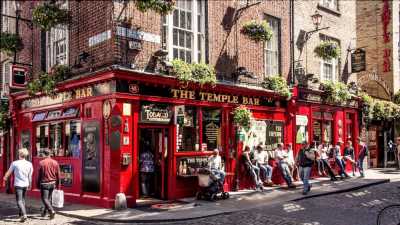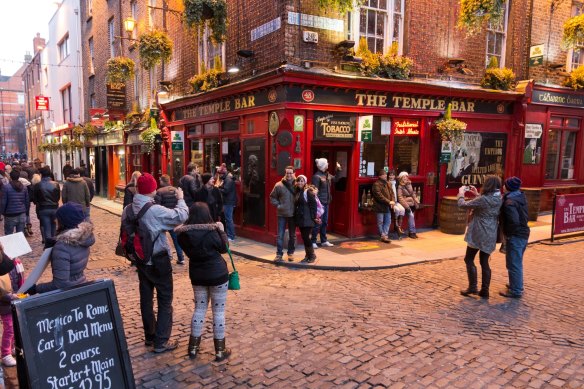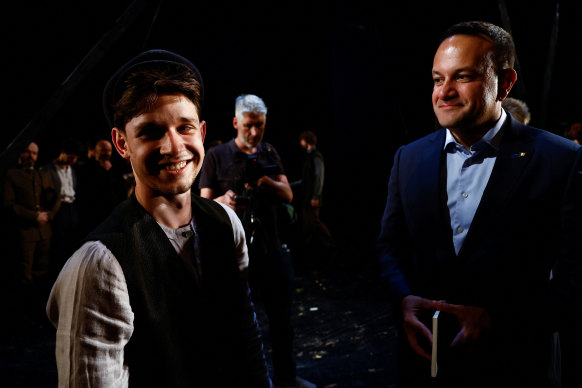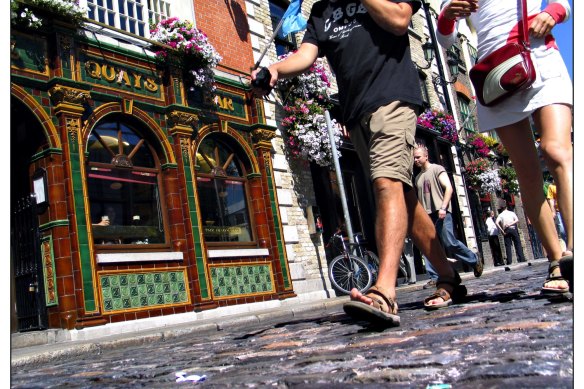
Save articles for later
Add articles to your saved list and come back to them any time.
Dublin: The famed cobblestone streets of Temple Bar have, for years, been a place where tourists flock for their first taste of locally brewed Guinness and singalong to traditional Irish folk tunes. It is, as the locals say, good craic.
But the normally cheerful streets of Dublin have been exposed to an increasingly sinister side in recent times, which business owners and the government fear could now severely damage the city’s reputation.
The Temple Bar historic district of Dublin, a city plagued by a rash of violence.Credit: Shutterstock
It is almost two weeks since the brutal assault of an American tourist sent shockwaves through the capital, throwing the spotlight on youth violence in the city. Several other attacks have followed, with three separate incidents alone last Monday further casting a shadow.
A woman in her thirties was hospitalised after an attack in Temple Bar, while later that night one man was assaulted and had to be taken to hospital and another was beaten during a fight with a group of teenagers on Ormond Quay.
The scale of the violence prompted the United States embassy to issue a security warning to its citizens, with a message printed across the website urging tourists and residents to “keep a low profile” and avoid walking alone after dark.
Assualted: American Stephen Termini.Credit: Gofundme/Internet
Social welfare groups have warned that decades of neglect of deprived communities have combined with a “lost generation” of children who slipped through the cracks during the pandemic and are now living “on the streets”. Many of the offenders have come from the inner north of the city, which is traditionally one of the poorest areas.
Stephen Termini, 57, from Buffalo in New York, emerged from a coma at the weekend but remains in a serious but stable condition, suffering “life-changing injuries” to his eye and head during the incident. He was punched and kicked numerous times in the head during the attack. Three teenage boys are facing charges over the attack, which happened near one of the city’s biggest police stations.
Termini’s sons have flown to Ireland to be by his side. Their images were plastered all over the TV news and weekend newspapers.
A fortnight earlier, Ukrainian actor Oleksandr Hrekov was glassed and bitten by a group of attackers outside a theatre after taking part in a performance of Brian Friel’s play Translations. He was hospitalised after the attack and has since returned to Kyiv with his group.
It was reported that two men and three women tried to take Hrekov’s cigarettes before an altercation occurred.
Ireland’s Prime Minister, Leo Varadkar, meets actor Oleksandr Hrekov as he visits Lesya Ukrainka Theatre in Kyiv in July.Credit: Reuters
More than 6 million tourists visit Ireland each year, creating 180,000 jobs and generating €3.9 billion ($6.45 billion) for the economy.
Against a backdrop of rising concern that the city centre has become increasingly violent since the pandemic, there have been promises by political leaders to get tough on the issue amid widespread criticism over a lack of police, or Garda, numbers in Dublin.
One Temple Bar business owner earlier this year described the area as a “war zone”. Niall Sabongi, of The Seafood Café, said violence and anti-social behaviour were threatening many businesses, with gangs of youths running into the cafe making racial and sexual slurs against staff.
Cathal Brennan, a historian who operates walking tours of the city, said the increase in violence had made him shorten his guided walks and re-assess their feasibility.
A troubled tourist hotspot: Temple Bar district in Dublin.Credit: Phil Carrick
“You end up avoiding areas that are just a bit sketchy,” he said. “I mean, 99 times out of 100 there could be no problems, but like, occasionally it just gets, you know, a drug addict or homeless people screaming at you. You sort of have a duty of care to the people on the tour, and the age demographic are older people a lot of the time.”
Brennan said that since the start of summer he’d seen just one policeman on patrol as he walked the city with groups of tourists, many of those in their 60s and 70s from the United States.
“If you went to Times Square, or you went outside Buckingham Palace, they’re normally very heavily policed. And there’s an idea that tourist areas are going to be safe for tourists to wander around. That’s not the case in Dublin,” he said.
The Irish Justice Minister, Helen McEntee, was widely mocked when she told reporters last week that she was often “out and about” safely without her personal protection team when socialising in the city. But on Friday, after senior police conceded the number of officers had fallen since the pandemic, she announced an additional €10 million ($16.5 million) for policing in the Dublin region.
“We welcome all tourists, and we want people to know that, for the most part, Ireland as a country, and our cities, are safe,” she said.
“There are problems no different to any other country, and we update our advice to people travelling from here, and other countries update their advice.”
Get a note direct from our foreign correspondents on what’s making headlines around the world. Sign up for the weekly What in the World newsletter here.
Most Viewed in World
From our partners
Source: Read Full Article



